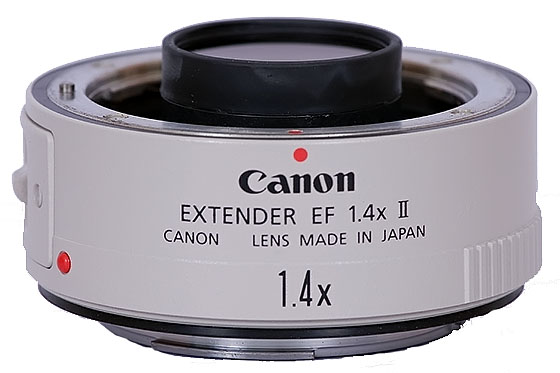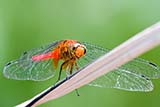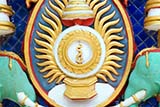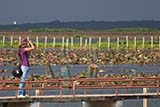Canon EF 1.4x II Extender Review
Sample Images
A selection of photos taken with the Canon EF 1.4x II Extender/Teleconverter used in conjunction with my EF 70-200mm f/4L IS and EF 300mm f/4L IS lenses in Thailand and Singapore.
Clicking on the thumbnail images will open a larger image in a pop-up window.
Lens: Canon EF 70-200mm f/4L
ISO: 200
Aperture: f/8.0
Shutter speed: 1/320
Focal length: 200mm
EC +/-: 0
Monopod/Tripod: No
Flash: No
Extender: No
Location: Hat Yai, Thailand
File Size: 186 KB
Lens: Canon EF 70-200mm f/4L
ISO: 200
Aperture: f/8.0
Shutter speed: 1/320
Focal length: 280mm
EC +/-: 0
Monopod/Tripod: No
Flash: No
Extender: Canon 1.4x II
Location: Hat Yai, Thailand
File Size: 137 KB
Lens: Canon EF 300mm f/4L
ISO: 200
Aperture: f/8.0
Shutter speed: 1/640
Focal length: 300mm
EC +/-: 0
Monopod/Tripod: No
Flash: No
Extender: No
Location: Hat Yai, Thailand
File Size: 144 KB
Lens: Canon EF 300mm f/4L
ISO: 200
Aperture: f/8.0
Shutter speed: 1/500
Focal length: 420mm
EC +/-: 0
Monopod/Tripod: No
Flash: No
Extender: Canon 1.4x II
Location: Hat Yai, Thailand
File Size: 127 KB
Lens: Canon EF 70-200mm f/4L
ISO: 200
Aperture: f/10.0
Shutter speed: 1/100
Focal length: 280mm
EC +/-: 0
Monopod/Tripod: No
Flash: No
Extender: Canon 1.4x II
Location: Hat Yai, Thailand
File Size: 142 KB
Lens: Canon EF 300mm f/4L
ISO: 400
Aperture: f/11.0
Shutter speed: 1/160
Focal length: 420mm
EC +/-: 0
Monopod/Tripod: No
Flash: No
Extender: Canon 1.4x II
Location: Hat Yai, Thailand
File Size: 137 KB
Lens: Canon EF 70-200mm f/4L
ISO: 200
Aperture: f/8.0
Shutter speed: 1/160
Focal length: 200mm
EC +/-: 0
Monopod/Tripod: No
Flash: No
Extender: No
Location: Hat Yai, Thailand
File Size: 340 KB
Lens: Canon EF 70-200mm f/4L
ISO: 200
Aperture: f/8.0
Shutter speed: 1/200
Focal length: 280mm
EC +/-: 0
Monopod/Tripod: No
Flash: No
Extender: Canon 1.4x II
Location: Hat Yai, Thailand
File Size: 289 KB
Lens: Canon EF 300mm f/4L
ISO: 200
Aperture: f/8.0
Shutter speed: 1/200
Focal length: 300mm
EC +/-: 0
Monopod/Tripod: No
Flash: No
Extender: No
Location: Hat Yai, Thailand
File Size: 264 KB
Lens: Canon EF 300mm f/4L
ISO: 200
Aperture: f/8.0
Shutter speed: 1/200
Focal length: 420mm
EC +/-: 0
Monopod/Tripod: No
Flash: No
Extender: Canon 1.4x II
Location: Hat Yai, Thailand
File Size: 219 KB
Lens: Canon EF 300mm f/4L
ISO: 200
Aperture: f/8.0
Shutter speed: 1/125
Focal length: 420mm
EC +/-: 0
Monopod/Tripod: No
Flash: No
Extender: Canon 1.4x II
Location: Singapore
File Size: 170 KB
Lens: Canon EF 300mm f/4L
ISO: 400
Aperture: f/6.3
Shutter speed: 1/500
Focal length: 420mm
EC +/-: 0
Monopod/Tripod: No
Flash: No
Extender: Canon 1.4x II
Location: Phattalung, Thailand
File Size: 152 KB
Lens: Canon EF 70-200mm f/4L
ISO: 200
Aperture: f/8.0
Shutter speed: 1/200
Focal length: 200mm
EC +/-: 0
Monopod/Tripod: No
Flash: No
Extender: No
Location: Singapore
File Size: 137 KB
Lens: Canon EF 70-200mm f/4L
ISO: 200
Aperture: f/8.0
Shutter speed: 1/200
Focal length: 280mm
EC +/-: 0
Monopod/Tripod: No
Flash: No
Extender: Canon 1.4x II
Location: Singapore
File Size: 134 KB
Lens: Canon EF 70-200mm f/4L
ISO: 400
Aperture: f/8.0
Shutter speed: 1/100
Focal length: 200mm
EC +/-: 0
Monopod/Tripod: No
Flash: No
Extender: No
Location: Singapore
File Size: 149 KB
Lens: Canon EF 70-200mm f/4L
ISO: 400
Aperture: f/8.0
Shutter speed: 1/125
Focal length: 280mm
EC +/-: 0
Monopod/Tripod: No
Flash: No
Extender: Canon 1.4x II
Location: Singapore
File Size: 124 KB
Lens: Canon EF 70-200mm f/4L
ISO: 200
Aperture: f/5.6
Shutter speed: 1/400
Focal length: 263mm
EC +/-: 0
Monopod/Tripod: Giottos Monopod
Flash: No
Extender: Canon 1.4x II
Location: Phattalung, Thailand
File Size: 142 KB
Lens: Canon EF 70-200mm f/4L
ISO: 200
Aperture: f/5.6
Shutter speed: 1/400
Focal length: 280mm
EC +/-: 0
Monopod/Tripod: Giottos Monopod
Flash: No
Extender: Canon 1.4x II
Location: Phattalung, Thailand
File Size: 188 KB
User Impressions
The Canon EF 1.4x II Extender has been a very useful addition to my camera bag. It's small and works well with my zoom lenses. The only drawback is that what you gain in focal length, you lose in light - one stop to be precise. However, this is an improvement over the 2x extender which has a two stop light penalty.
Using the extender doesn't affect the minimum focusing distance of the lens. Some of the bug shots above were taken at roughly the minimum focusing distance of the 300mm f/4L IS.
All of my current lenses have a maximum aperture of f/4. When I add the extender, that maximum aperture is effectively decreased to f/5.6. On my xxD bodies the autofocus still works at f/5.6. However, if I were to use the extender with a lens that had a maximum aperture of f/5.6, it would be decreased to f/8.0 and then the autofocus wouldn't work.
If you use a professional EOS-1 series camera it won't be a problem because these bodies autofocus at F8. Alternatively, I have read lots of reports about people putting tape over certain electrical contacts on the lens to get round this problem.
I have no experience of doing this so can make no comments.
Another comment that I have read repeatedly is that the extender degrades image quality. I guess the logic is that the more elements you place in between the sensor (or film) and subject, then the more the image will be degraded.
But in practice, is that the case? Click on the photos above to get a larger version and judge for yourself whether you think the image quality has been degraded.
The photos above are of the same subject so that you can make a comparison. Where there are four photos of the same subject I have kept the magnification aspects the same so you can see what difference the extender makes to the size of the subject.
Images used for comparison had exactly the same post-processing applied. There may be slight differences with the exposure due to the composition being different with each lens combination.
Lens Compatibility
According to Canon, the EF 1.4x II Extender is compatible with, "fixed focal length lenses 135mm and longer (except the 135mm f/2.8 Softfocus lens), and the EF 70-200mm f/2.8L, 70-200mm f/2.8L IS, 70-200mm f/4L, 70-200mm f/4L IS USM, and 100-400mm f/4.5-5.6L IS zoom lenses."
With the 100-400mm f/4.5-5.6L IS at certain zoom lengths, presumably you will run into AF problems using this lens combination on a body that only autofocuses up to f/5.6.
Compared To The 1.4x III
I bought my Canon EF 1.4x Extender II several years before the Canon EF 1.4x Extender III was announced in 2010. The optical quality is so good with the Mark II that I had no interest at all in upgrading to the later version.
The EF 1.4x III extender is no doubt a better product, but considering that I don't use Canon's best lenses or biggest sensors my opinion was that I (personally) wouldn't see any improvement in image quality with the Mark III. This may not be the case if you pixel peep using the 50MB sensor in a 5DS in conjunction with a very high quality lens.
I don't have an EF 1.4x Mark III so can't make direct comparisons, but for me personally I didn't think it would be worth upgrading. Apart from maybe a small improvement in image quality, I assumed that the Mark II and Mark III versions were identical. However, this may not be quite the case.
When the Canon 80D was announced in 2016 I discovered that it could autofocus at f/8. Occasionally, I like to visit areas of wetland near to where I live in southern Thailand to photograph birds and the prospect of being able to use my Canon EF 400mm f/5.6L and EF 1.4x II on a 1.6x crop body that would autofocus with that lens combination appealed to me.
A quick look at the 80D user manual confirmed this was the case, but with this combination only the centre AF point could be used. Using the EF 1.4x III makes no difference with the Canon EF 400mm f/5.6L. Regardless of the version of Canon EF 1.4x extender used with this camera/lens combination, only the center AF point can be used.
What I found very interesting as I browsed through the different lens and extender combinations in the Canon 80D user manual is that the extender version used does make a difference when used with the Canon EF 100-400 f/4.5-5.6L IS Mark II (the extender version used makes no difference with the Mark 1 version of this lens).
When using the EF 1.4x II extender with the EF 100-400 f/4.5-5.6L IS Mark II only the center AF point can be used, however, when using the EF 1.4x III extender with the EF 100-400 f/4.5-5.6L IS Mark II it is possible to autofocus using 27 AF points.
I found this interesting and it implies that there are more differences between the Mark II and Mark III 1.4x extender versions than I initially thought. If at any stage I end up getting a Canon 80D and Canon EF 100-400 f/4.5-5.6L IS Mark II, it would make sense to upgrade to the EF 1.4x III so that I could take advantage of an extra 26 AF points.
If money is no object and if you buy the latest and best Canon products, don't even think about it. Just buy the Mark III. If money is an object, if you don't use the highest quality bodies and lenses, and if they are still available to buy where you live, the Mark II will most probably be good enough for your needs. It is for mine.
Post-Processing
Most original images were shot in the RAW format and converted with Adobe Camera Raw. Noise was reduced using Imagenomic Noiseware Professional. Small amounts of image enhancement were applied using Adobe Photoshop CS2 (curves, levels, saturation) before sharpening using the Smart Sharpen filter (Amount: 30% - 120%, Radius: 0.2px - 0.3px, Remove: Lens Blur).
JPG images were saved with a 'High' quality setting of '8' on a scale of 0-12.
Lens Details
Weight: 7.8oz; 220g
Date Purchased: December 2006
Supplier: Cathay Photo, Singapore
Price: SGD$677.25
Soft Case: LP811 (included)
Other Review Pages You May Be Interested In




















